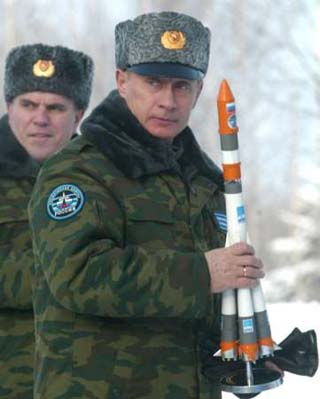
RUSSIA SERIOUS ABOUT INF TREATY ABROGATION
RUSSIA SERIOUS ABOUT INF TREATY ABROGATION
The Russian military always disliked the Intermediate-Range Nuclear Forces (INF) Treaty, signed in 1987 by Presidents Ronald Reagan and Mikhail Gorbachev. The INF eliminated all U.S. and Russian ballistic missiles (some 2,700 all in all) with a range from 500 to 5500 kilometers. The Russian SS-20 or Pioneer missiles that carried three warheads each and had a range of up to 5,500 km were scrapped. The United States destroyed its highly accurate Pershing-2 missiles.
The mutual destruction of SS-20s and Pershings was seen as regrettable, but fair to the Russian military. But what made the generals mad was the scrapping of the SS-23 (Oka) missiles. Ever since 1989, when the Oka was destroyed, the generals have lamented its loss and accused Washington and Gorbachev of ill intent that had deprived them of a potent weapon for no good reason. The SS-23 was never tested to fly more than 400 kilometers, according to the generals, so it should not be part of the INF agreement (Strana.ru, February 16).
This month the long-standing resentment against the INF became public in a dramatic fashion. First, on February 7 Defense Minister Sergei Ivanov (later promoted to first deputy prime minister on February 15) announced in the Duma that the INF was “a big mistake”, that it “had a negative impact on our security” since it “eliminated a whole class of missiles.” Ivanov added, “Having them would not hurt” (Fednews.ru, February 7).
Several days later, President Vladimir Putin’s criticism of U.S. policy was much reported. But he also complained that under the IMF the United States and Russia are both banned from having medium-range missiles, while other countries are free to develop and deploy such weapons. Putin then declared, “In such circumstances we will be forced to consider safeguarding our security” (Kremlin.ru, February 10). Ivanov, speaking in Munich one day after Putin, called the INF “a relic of the Cold War” that “will not last forever” (mil.ru, February 11).
With Putin and Ivanov, his possible successor, openly attacking the INF, the treaty’s future seems precarious. Last week General Yuri Baluyevsky, chief of the General Staff, added to the debate by announcing that Russia might unilaterally withdraw from the INF. Baluyevsky linked the INF abrogation with possible deployments of U.S. missile defense in Europe (RIA-Novosti, February 15).
Gorbachev spoke up to defend the INF, arguing it was not “a mistake,” but a balanced arms reduction treaty (Interfax-AVN, February 9). However, no one in Russia listens to Gorbachev any more. The commander of the Strategic Rocket Forces, General Nikolai Solovtsov, announced Monday, “If a political decision is taken to abrogate the INF, new medium-range missiles to replace the SS-20 may be developed in five to six years.” Solovtsov added, “If a decision is taken, we will be able to target U.S. missile defenses in Poland and the Czech Republic” (RIA-Novosti, February 19). At the same time, Solovtsov insisted that while there are yet no missile defense deployments in Poland and the Czech Republic, talk of targeting is premature. Solovtsov also acknowledged that the placement of only ten silo-based U.S. interceptors in Poland would not threaten Russian missile forces. “Only if there are further deployments will a threat arise,” he added.
All the clamor in Moscow about Poland and the Czech Republic seems to be mostly a pretext to cancel the INF. The Russian military has a serious and concrete reason to seek to end the treaty, and they have apparently managed to convince political leaders that the INF is wrong and unfair.
To compensate for the Oka, Russia developed another missile, the Iskander-M, with a declared range of 280 kilometers, a half-ton payload, and enhanced accuracy. Plans have been announced to deploy five rocket brigades of Iskander-M missiles by 2015, with the formation of the first brigade beginning this year. In fact, the Iskander-M has potentially a bigger range (up to 500 kilometers) than officially announced. To realize the full Iskander-M potential and make it a more potent weapon, the INF must go (Strana.ru, February 16).
During the invasion of Chechnya in 1999 and 2000, the Russian military used SS-21 (Tochka-U) ballistic missiles to attack Chechen towns and villages (Nezavisimoe Voennoe Obozrenie, October 29, 1999). Russian Air Force attack helicopters and fixed-wing aircraft are old and badly maintained because spare parts are in short supply. The pilots are untrained, because they lack adequate flying practice. Russia does not have modern, airborne, precision-guided weapons. But ballistic missiles can fill the gap.
The SS-21 has a range of 120 kilometers. Using mobile launchers deployed in North Ossetia and in Dagestan, the Russian military could effectively cover all of Chechnya during the 1999-2000 offensive. But should a conflict erupt elsewhere in the Caucasus or, perhaps, in Crimea near Sevastopol, the SS-21s deployed in the North Caucasus will be of little help, and the Iskander-M will be useful only with a range enhanced to 500 kilometers.
While the Kremlin rhetoric is today aimed at Washington and its possible strategic missile defense deployments, the true target is the INF. Moscow wants to deploy new missiles that cannot reach the United States, but are designed for neighbors. That was in essence the thrust of Putin’s Munich speech, aimed at the West: Accept us as equals and give us at last our sphere of influence within the region. Keep out! Stop poking into our neighborhood — or we may go ballistic.


